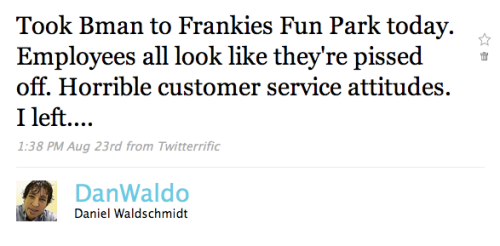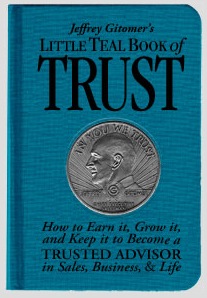
Two stories. One central theme.
It all started on Friday with a call from my friend, Jill Stelfox…
Between a mix of tears and laughing she told me how she had been working to secure a vendor to tape video footage of one of her clients. Her client is a financial planner who is on MSNBC as a leading source of “money talk” and so she wanted to get a copy of all his appearances to add to his website. (Sounds like a good plan to me…) So she reached out to several different vendors who quoted her prices between $125 to $150 per tape clip. One vendor though struck a different tone. He offered to provide the service at $85 per clip – provided she bought 25 up-front – and even suggested he send her a sample of her client on video.
Pleased, Jill provided more information, and a short bit later the vendor sent over the video. After looking at the tape Jill called the vendor with a serious problem — the audio and video were synced horribly like a bad Chinese Kung Fu movie. Jill’s client was talking and his lips were moving “out of timing” with the audio. The video quality itself was “super spotty”. Still — this was a FREE sample. Maybe there was a good explanation (or not).
The vendor listened as Jill spoke and then professionally admitted that there was a problem. He then went on to note that he “knew there was a problem and that was why he was asking for 25 up-front purchases – so he could upgrade his equipment”… (all true, I promise). He then went on tell Jill that “he was broke and needed the money to do more work for other prospects.”
It took little time for Jill to hang up the phone in disbelief and end a shockingly bizarre buying experience.
Saturday evening Sara and I were “first person” to our own outrageous buying experience. It went a little something like this:
There is an children’s arcade/amusement center called Frankie’s Fun Park about 10 minutes from our house in Greenville that my two boys (Bryce and Dustin) love for me to take them. I just went there a few weeks ago when Sara was out-of-town and found the scene morbidly un-engaging. Employees were frowning and yawning – like we customers were a chore that they were forced to take care of. Needless to say, I took the boys home without spending any more money. I also took the 15.4 seconds necessary to “tweet” to the world about my poor experience. And then told the boys that we would never be heading back there again…

But, alas, the allure of winning tickets and climbing through indoor jungle gyms was too much for the boys to accept. They wanted to return and I wanted to make that happen for them. Besides, Bryce had won almost 2,000 tickets that he had not cashed in for prizes yet. And so we made our way back into the den of sweaty over-caffeinated kid-dom.
The boys headed straight for the “jungle gym”. Shoes off and stowed in cubby. Borrowed socks on. Fun everywhere with mom and dad cheering on the mayhem (I wish they made one of those for adults…). It was when the boys got out that the problem began. Dustin (my 2 year old) had his bright yellow crocs stolen out of his cubby — cubby that his mom and I were standing 5 feet away from the entire night. Sure — someone might have accidentally picked up the bright yellow crocs by accident (hardly….) — but it was the way the employees handled it that made this a story.
Of course I mentioned this to the 17- year old staff member in that kids area who took a few seconds away from texting to look at me with one eye raised. “Steal your kids shoe?” she repeated back to me incredulously — like I was making the entire story up for. Further outraged, I moved on to the front of the establishment to look for management. Maybe someone old enough to have a car payment would care about my son’s bright yellow crocs. Sadly I was mistaken.
When I reached the front desk the manager came hustling out to meet me, chattering in half-tones into an ear piece about some food cleanup. Without any eye contact, he briefly stopped to tell me that he had “everyone looking for my shoe and that he was sure no one had stolen my sons’s bright yellow crocs.” To which I kindly refrained from sucker punching him in his face and left with Sara and the boys. I came to spend money and was left shoeless and insulted. Another horrible customer experience at an establishment that should be completely focused on user satisfaction.
What’s the point? It’s simply this.
It’s all about the EXPERIENCE your customers are having! You can’t explosively grow your revenue when you are pissing off the people who have the revenue to help you grow. You invest in them FIRST so that they will invest in you FOREVER.
And remember — It’s not about their trial period
…………………………or your proof-of-concept expectations
………………………………….or the support ROI you are factoring
…………………………………………..or “who is right” when a prospect complains.
It’s about how a prospect FEELS while interacting with you. Michael Ports (what a great author…) made the observation that: “Long after people forget what you said or did, [customers] will remember how you made them feel.”
It’s feelings that we need to change. Not facts!
By the way, that means that logic or facts have nothing to do with this discussion. At the heart of this is the concept of “relationships” — which happen to be completely illogical. You can’t build a spreadsheet around a customer experience strategy or “doing the right thing” (which is why so many companies just hire more schmucky sales dudes to find more prospects rather than get religious about creating an outrageous experience for their “community”).
You can’t even explain how you are going to make more money doing this. But it works. It’s the stuff of legends.
- It’s the pricing and staffing economics that make Southwest Airlines the only profitable airline in the US and the most enjoyable (non-luxury) traveling experience….
- It’s what takes the idea of outrageous customer fulfillment and ten years of consistent performance to build a billion dollar online site like Zappos…
- It’s the detailed online client “do-it-yourself” tools that catapult a small franchise like Washington Mutual into a leading insurance powerhouse…
- It’s the efficiency of client purchases and delivery that propel Amazon.com to be the leader in online purchases…
- It’s the foundation of an ACE Hardware franchise that continues to “delight” even while getting smashed by larger Home Depot and Lowe’s franchises…
It’s easy to call this “too intangible for action” and just add more dollars to the CRM budget next year. This takes guts. And faith. And obsessing about the details of everything you do and every word you train your people to say. It is a religion.
But “strangely”, when you invest in your customer’s experience, you emerge as the alpha-standard. You don’t just improve mediocrity. You set the standard for the new “impossible”. You are invincible!
Your ability to achieve explosive revenue growth is directly proportional to your obsession with providing an outrageous customer experience. Suck at one and you’re guaranteed to suck at the other… (DEWism)
———————————————————-
Possibly coincidence, but my CEO friend, Kriss Wilson, tweeted me over the weekend to tell me about his horrible 8-hour experience with Dell support. You have to check it out!!
 Since when did we as business people decide that having conversations was too much work?
Since when did we as business people decide that having conversations was too much work?




